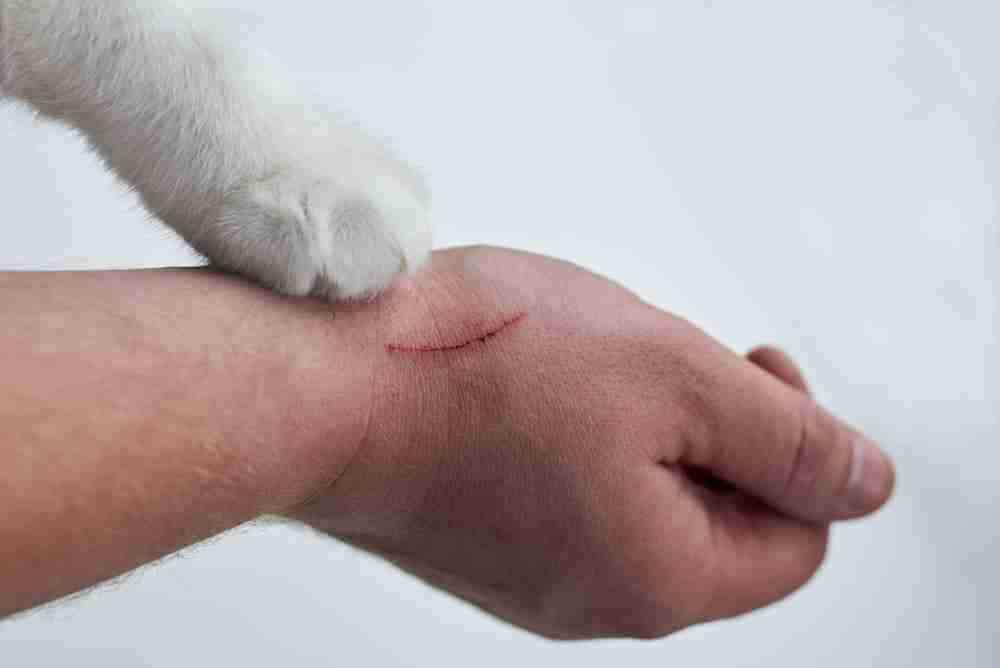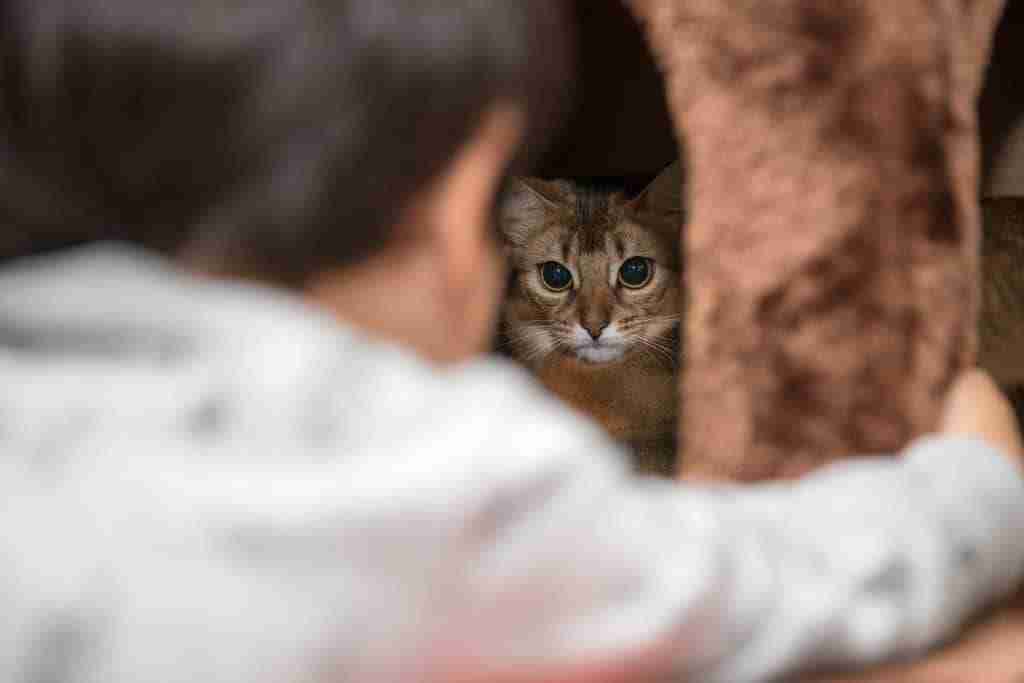Can you get sick from a cat? Could your pet make you ill? Unfortunately, yes they can. You can catch a whole host of bacterial and fungal infections from your cat. You can also get infected by parasites and protozoal organisms. Read on to learn about the risks.
There are over 94 million pet cats in America making them the second most popular pet after freshwater fish. Many cat owners are well aware of the benefits the pet cat brings to the household-they provide company, and entertainment, in some circumstances can improve health, and generally prove to be easy to maintain as a pet given their independent nature. What fewer owners might be aware of is that their cat can pose a health risk, your cat could make you sick – or worse!
Let’s check, in no particular order, how your cat might make you sick, look at the numbers and see what we can do to minimize the chances of a problem occurring.
Bacterial Infections
There are a number of bacterial infections you could potentially catch from your pet cat.

Cat Scratch Fever
There are 12000 cases reported per year in the US so you can consider yourself unlucky if you get this infection from your cat considering there are 92 million pet cats who all probably scratch someone at some point during the year!
The infection is actually caused by a bacterium called Bartonella henselae which is passed from cat to cat by infected fleas. The infection causes a fever, swollen lymph nodes, headaches, joint pain, bumps, and blisters in humans at the scratch site.
In healthy adults, the fever and symptoms usually appear in 7-14 days and can take months to resolve, in children it is wise to get a tetanus shot. Most cases are found in children under the age of five due to the way they interact with cats.
In immunosuppressed individuals, the infection can lead to serious complications and potentially death. Those with severe symptoms, complications, or known to have suppressed immune systems are usually treated with antibiotics.
This is a health hazard you should be aware of but not necessarily fret over – the numbers demonstrate the risk is generally low.

Pasteurella Multocida
There are 216000 cat bite wounds per year historically in the US found to contain p.multocida (that’s 75% of all cat bite wounds). Basically, if you get a cat bite you have a high risk of being infected as the cat’s respiratory microbiome homes this nasty little bacteria.
The bacteria can cause the bite wound to show signs of infection such as inflammation and swelling but more worryingly this toxic bacteria can cause heart infections and even meningitis if left untreated – potential killers!
This small 2015 study of 24 individuals infected via animal bite found that 11 needed inpatient treatment and 1 needed ICU, the others were treated as outpatients.
Treatment is usually a course of antibiotics. Again, with 92 million cats the odds are low that you will get this – but if your bitten get sorted immediately, this can turn serious very quickly if left unattended.
Salmonella
There are over 1.2m million cases of Salmonella in the US every year. Well over 1m of the cases are caused by food contamination, but did you know you could catch Salmonella from your cat?
Well you can – but it is very, very rare. Less than 10 cases per year are directly attributable to cats and then usually they are outbreaks related to a veterinarian environment.
Salmonella has the potential to cause death but very low likelihood even when infected.
Usually treated by keeping fluids up and using loperamide to reduce diarrhea.
In severe cases where the bacteria has entered the bloodstream or in immunosuppressed individuals, antibiotics are used to treat the infection.
Chances of getting salmonella from your cat – remote but possible.
Parasites
Unfortunately, our cats do tend to suffer with parasites – luckily cat parasites don’t take to humans that well. Here is what you might encounter :
Fleas
There 10.9 cases of fleas per 100 cats so of 94 million pet cats 10 million have fleas at anyone time!
Cat fleas do not cause human illnesses – just irritation from the odd bite. It is thought that cat fleas are the general transmission agent for CSD between cats.
Cat fleas don’t reproduce on humans or do well living on humans so you are unlikely to suffer too much if your cat has fleas.
Cat fleas represent a mild inconvenience to humans and offer no risk beyond the odd itchy bite. Check out our tips for getting rid of cat fleas off your furry friend if they happen to be the 1 in 10…
Scabies
Your pet cat doesn’t harbor human scabies mites but it may have cat scabies. These parasites don’t take to humans, fortunately – they usually die in a few days on humans and don’t reproduce.
You may get a slight skin rash but nothing more. Low risk.
Fungal Infection
Fungal infections from your pet cat are rare but possible :
Ringworm
As many as 7% of fifth graders may have ringworm fungus in the USA (athlete’s foot, jock itch, etc). This irritating fungal infection can be caught from human to human or human to pet exposure.
The fungus can remain on clothing, furniture as well as skin so can be difficult to eradicate without a top to bottom clean-up.
Usually treated with antifungal creams. There is a low risk of serious health implications in healthy adults but a potential danger of fatal fungal infection in immunosuppressed individuals.
Your pet cat can bring it into your household but no one knows how many instances are caused by pet-to-human contact – it is assumed most infections are spread in dressing rooms, shared wash areas, and other public spaces and spread human to human.

Protozoal Infections
These infections are caused by small single-cell organisms. Often waterborne or present in infected soil they contaminate surfaces and once ingested can often cause diarrhea, fever, and the like:
Giardiasis
This is a waterborne infection that results in diarrhea, malabsorption of nutrients, cramps, hives, and itchy skin. Usually resolves itself but you can take medication to resolve the infection if necessary.
Chances of infection from pet cats are very small (negligible) as the type of giardiasis is different from that that humans suffer from – the medium risk of damage to health but a low likelihood.
Most infections occur in areas where the infection is endemic, most are spread from person to person (usual children in daycare), total of 15000 infections in 2012 in the whole of the USA from all sources to give you an idea of prevalence…
Take basic precautions, wear gloves gardening and wash hands after contact with soils, etc, same if you deal with a litter tray and you should drastically reduce the odds of having problems.
Cryptosporidiosis
Another waterborne infection that is spread through contamination of soil and water through animal and human fecal matter.
Can be spread by contaminated water, dirty hands, or dirty surfaces. Causes diarrhea, cramps, nausea, and other symptoms – most people recover after a few weeks but some medications are available for treatments where symptoms are very bad.
Can be caught off your pet cat so washing hands and keeping surfaces clean is important.
May prove fatal to individuals with a suppressed immune system.
Up to 750,000 people get a bout of crypto in the US each year, it is a growing problem due to crypto’s ability to withstand chlorination.
The potential hazard is low risk in healthy adults but much more common than other infections you could get from a cat.
The takeaway is to wear gloves working outdoors, wash hands after outdoor activity, wear gloves and wash hands handling a litter tray and disinfect food preparation areas that cats might have jumped on before preparing food.
Toxoplasmosis
Toxoplasmosis infection is surprisingly common – it is believed that up to 60% of the world population are infected with up to 11% of people in the US infected!
Most infections are caused by either poorly cooked food, exposure to cat feces or mother-to-child transmission.
Cats carry the infection from ingesting infected mammals/birds then poop cysts out into the garden or cat litter that can infect humans if they come into contact through touch leading to ingestion. An estimated 1% of cats in the USA are actively shedding oocysts that transmit the infection at any one time.
Generally causes no symptoms in healthy adults, although you might get flu-like symptoms for a week or so after infection. There is some thin early evidence to show it might lead to mental health issues in later life and may cause car accidents but data is very limited.
The biggest danger is to pregnant women or immunosuppressed individuals.
Cat owners or gardeners should wear gloves whilst in contact with soils or litter trays and wash hands after activity to reduce transmission rates.
Viral Infections
When it comes to a cat to human transmission of viral infections the number one danger is rabies:
Rabies
To put the risk into context there are usually 1-3 cases of human rabies infection annually in the USA. 250 cats are found to be rabid each year (always unvaccinated animals). Of the human cases, most over the last 10 years have come from bites or contact with bats or bites from rabid dogs. Basically, get your cat vaccinated and you are not at risk.
Transmission occurs when unvaccinated dogs and cats are exposed to rabid wildlife such as foxes, raccoons, skunks, and bats. They can become rabid and pose a threat to humans they bite.
If bitten you need treatment immediately – usually, a course of injections into the arm spread over a 14-day window. If you leave it, once clinical symptoms emerge you can’t be saved – a painful death is the only outcome.
Get your pet vaccinated and the risk disappears – just be careful handling cats you don’t know well.
Conclusion
In general, if you are in good health you shouldn’t be overly worried about negative health consequences or risks from owning a cat.
So long as you avoid being bitten and take basic hygiene precautions – wear gloves gardening or dealing with litter trays, keep food preparation surfaces clean and wash your hands properly before preparing food or eating, you should be at very, very low risk and be able to enjoy all the health benefits of cat ownership.
No matter who you are, if you are bitten you should seek medical help immediately as the risk of infection and sickness is much higher when bitten and can lead to seriously unhealthy outcomes.
